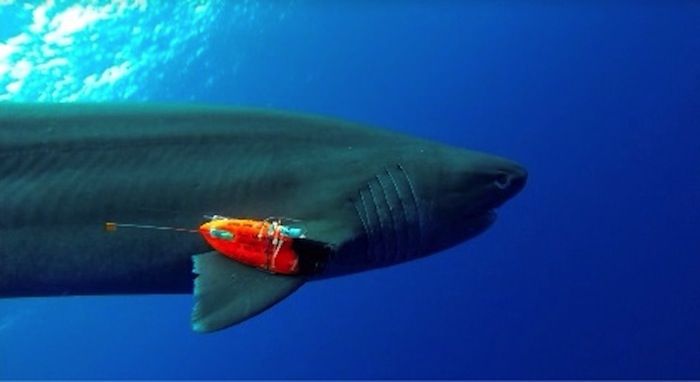'Shark's Eye' Videos Capture Predators' Mysterious Habits

Sharks equipped with sophisticated sensors and video cameras are helping researchers uncover new clues about their swimming and eating habits, a new study finds. These novel, "shark's eye" views are illuminating some of the least-understood behaviors of these shadowy marine predators.
Researchers at the University of Hawaii, in Honolulu, and the University of Tokyo monitored sharks using recording devices and sensors that were strapped to, or ingested, by the large fish. The instruments are providing new glimpses into the lives of sharks in their natural habitat, including where the sharks are going, how they reach their destinations, and what the toothy predators, at the top of the ocean food chain, are eating.
"What we are doing is really trying to fill out the detail of what their role is in the ocean," Carl Meyer, an assistant researcher at the Hawaii Institute of Marine Biology at the University of Hawaii at Manoa, said in a statement. "It is all about getting a much deeper understanding of sharks' ecological role in the ocean, which is important to the health of the ocean and, by extension, to our own well-being." [See video captured from a shark's eye view]
The videos, captured from the sharks' perspective, have recorded unprecedented views of them interacting with other fish, traveling in schools made up of different shark species, and swimming in loops across the seabed, the researchers said.
"It has really drawn back the veil on what these animals do and answered some longstanding questions," Meyer said.
Analysis of the footage also revealed that sharks use powered swimming to move through the ocean more often than smoother gliding motions, as scientists had previously speculated. Deep-sea sharks were also found to swim slower relative to species that populate shallower waters, the researchers added.
"These instrument packages are like flight data recorders for sharks," Meyer said. "They allow us to quantify a variety of different things that we haven't been able to quantify before."
Sign up for the Live Science daily newsletter now
Get the world’s most fascinating discoveries delivered straight to your inbox.
This is the first time sharks have been so extensively tracked. Previously, sharks had only been observed in captivity, and tracking efforts focused primarily on their migration habits, the researchers said.
Meyer and Kim Holland, also a researcher at the Hawaii Institute of Marine Biology, are presenting the findings today (Feb. 27) at the American Geophysical Union's 2014 Ocean Sciences Meeting, which is being held this week in Honolulu.
In addition to sharks, the researchers are also monitoring other ocean predators, including tuna. The ingested instruments use electrical measurements to keep track of digestion, which can help researchers figure out when, where and how much the fish are eating.
Their findings could help guide conservation efforts, shape public safety measures and provide detailed information for resource management, the scientists said.
Follow Denise Chow on Twitter @denisechow. Follow Live Science @livescience, Facebook & Google+. Original article on Live Science.

Denise Chow was the assistant managing editor at Live Science before moving to NBC News as a science reporter, where she focuses on general science and climate change. Before joining the Live Science team in 2013, she spent two years as a staff writer for Space.com, writing about rocket launches and covering NASA's final three space shuttle missions. A Canadian transplant, Denise has a bachelor's degree from the University of Toronto, and a master's degree in journalism from New York University.











